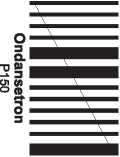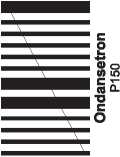Ondansetron 8 Mg Film-Coated Tablets
Pharmacode position may change as per Supplier's m/c requirement ^additional small pharma code may appear on the front / back panel


Package leaflet: Information for the user
Ondansetron 4 mg film-coated tablets Ondansetron 8 mg film-coated tablets
Ondansetron (as hydrochloride dihydrate)
Read all of this leaflet carefully before you start taking this medicine because it contains important information for you.
Keep this leaflet. You may need to read it again.
If you have any further questions, ask your doctor or pharmacist.
This medicine has been prescribed for you only. Do not pass it on to others. It may harm them, even if their signs of illness are the same as yours.
If you get any side effects, talk to your doctor or pharmacist. This includes any possible side effects not listed in this leaflet.
In this leaflet:
1. What Ondansetron is and what it is used for
2. What you need to know before you take Ondansetron
3. How to take Ondansetron
4. Possible side effects
5. How to store Ondansetron
6. Contents of the pack and further information
1. What Ondansetron is and what it is used for
This medicine contains ondansetron, which belongs to a group of medicines called anti-emetics, which help to stop you feeling or being sick.
Ondansetron is used to treat nausea (feeling sick) and vomiting (being sick) caused by some medical treatments, such as chemotherapy or radiotherapy for cancer (in adults and children). It is also used to prevent nausea and vomiting in patients following an operation (adults only).
2. What you need to know before you take Ondansetron
Do not take Ondansetron
• if you are allergic to ondansetron or any of the other ingredients of of this medicine (listed in section 6).
• if you have ever had any allergic (hypersensitive) reaction with other antiemetics (for example granisetron or dolasetron)
• if you are taking apomorphine (used to treat Parkinson's Disease)
Warnings and precautions
Talk to your doctor or pharmacist before taking Ondansetron
• if you have a blockage in your gut or suffer from severe constipation
• if you are due to have surgery to the adenoids or tonsils
• if you have a heart problem
• if you have an uneven heart beat (arrhythmias)
• if you have liver problems
• if you have problems with the levels of salts in your blood, such as potassium and magnesium.
If any of the above apply, you should inform your doctor before beginning treatment with Ondansetron.
Other medicines and Ondansetron
Ondansetron may have an effect on other drugs and other drugs may have an effect on Ondansetron.
Please tell your doctor or pharmacist if you are taking or have recently taken any other medicines, including medicines obtained without a prescription.
In particular it is important to tell your doctor if you are taking any of the following medicines:
• Medicines used to treat epilepsy (phenytoin, carbamazepine)
• Rifampicin (an antibiotic).
• Tramadol (a medicine used to treat pain)
• Medicines used to treat heart problems such as abnormal heart beats (anti-arrhythmics) and/or high blood pressure (beta-blockers)
• cancer medicines (especially anthracyclines) as these may interact with
Ondansetron to cause heart arrhythmias * antibiotics (such as erythromycin or ketoconazole),
Pregnancy, breast-feeding and fertility Pregnancy:
If you think you might be pregnant, or are planning to get pregnant, tell your doctor before you take Ondansetron.
The safety of using Ondansetron during pregnancy has not been established. Therefore the use of Ondansetron is not recommended during pregnancy.
Ask your doctor or pharmacist for advice before taking any medicine.
Breast-feeding:
You should not breast-feed your infant whilst taking Ondansetron. Ask your doctor or pharmacist for advice before taking any medicine.
Driving and using machines
Ondansetron is unlikely to affect your ability to drive or operate machinery. Ondansetron contains
Ondansetron contains lactose. If you have been told by your doctor that you have intolerance to some sugars, contact your doctor before taking this medicinal product.
3. How to take Ondansetron
Always take this medicine exactly as described in this leaflet or as your doctor or pharmacist has told you. Check with your doctor or pharmacist if you are not sure.
Treatment of sickness (nausea and vomiting) in patients receiving chemotherapy or radiotherapy:
Adults (including the elderly): The usual dose is 8 mg of Ondansetron 1 to 2 hours before chemotherapy or radiotherapy, followed by 8 mg of Ondansetron 12 hours later. To protect against delayed, or further, sickness a dose of 8 mg of Ondansetron may be continued twice a day for up to 5 days after treatment.
Infants and Children (aged 6 months and overt and adolescents (under 18 years oldl:
Your doctor will decide what dose of Ondansetron should be given. This will depend on the size and weight of the child.
Patients with liver problems:
The total daily dose should not be more than 8 mg.
To prevent sickness (nausea and vomiting) after an operation:
Adults: The usual dose is 16 mg before your operation or an 8 mg tablet one hour before the operation, then
another 8 mg tablet eight hours after the first dose, then a further 8 mg tablet eight hours after the second dose
If you are sick (vomit) within one hour of taking an 8 mg dose:
Take another 8mg tablet
Otherwise, do not take more Ondansetron tablets than the label says.
If you take more Ondansetron than you should
If you have taken too many tablets it is important to contact your doctor as soon as possible or go to your nearest hospital casualty department immediately. Take the medicine packet with you, even if there are no tablets left, so that the doctor knows which tablets were taken.
If an overdose has been taken, symptoms may include problems with vision, low blood pressure (which could cause dizziness or faintness) or irregular heart beat.
If you forget to take Ondansetron
If you forget to take a dose, take it as soon as you remember unless it is nearly time for your next dose. Do not take a double dose to make up for a forgotten dose.
If you stop using Ondansetron
Do not stop taking your tablets, even if you are feeling well, without consulting a doctor.
Black
P150
If you have any further questions on the use of this product, ask your doctor or pharmacist.
4. Possible side effects
Like all medicines, this medicine can cause side effects, although not everybody gets them.
If any of the following effects happen, stop taking your tablets and tell your doctor immediately:
An allergic reaction. The symptoms may include:
Sudden wheezing and chest pain or tightness
Swelling of the eyelids, face, lips, mouth tongue or throat
Difficulty breathing
Collapse
Skin rash
Fits (seizures)
Chest pain
Temporary loss of vision which usually comes back within 20 minutes Side effects of Ondansetron
If you are concerned about any side effects please talk to your doctor. If any of the following side effects gets serious, or if you notice any side effects not listed in this leaflet, please tell your doctor or pharmacist.
Very common side effects (affecting more than 1 person in every 10):
• Headache
Common side effects (affecting less than 1 person in every 10):
• Sensation of flushing and warmth
• Constipation
• Local burning sensation (following insertion of suppositories).
• Local IV injection site reactions
Uncommon side effects (affecting less than 1 person in every 100):
• uncontrollable movements of the body, including upward rolling movement of the eyeballs
• Fits (seizures). If this should occur seek urgent medical attention
• Dizziness (during rapid IV administration)
• (Irregular heart beat, fast or slow heart rate
• Chest pain. If this should occur seek urgent medical attention.
• Low blood pressure
• Hiccups
• An increase in liver function test results (most often in patients receiving chemotherapy with cisplatin)
Rare side effects (affecting less than 1 person in every 1000):
• An immediate allergic reaction, which may be serious and include symptoms such as sudden wheezing and chest pain or tightness, swelling of the eyelids, face, lips, mouth, tongue or throat, difficulty breathing, collapse, skin rash. If this should occur, seek urgent medical attention.
• Visual disturbances e.g. blurred vision (though this has almost always been associated with an Ondansetron injection rather than tablets).
• Effects on heart rhythms that can be seen on an ECG (an electrical trace of your heart). Symptoms may include feeling lightheaded or loss of consiousness.
Very rare side effects (affecting less than 1 person in every 10,000):
• Temporary loss of vision which usually comes back within 20 minutes. If this should occur seek urgent medical attention. Temporary loss of vision has almost always been reported with Ondansetron injection, rather than tablets, and usually when given with chemotherapy containing cisplatin.
If you get any side effects, talk to your doctor or pharmacist. This includes any side effects not listed in this leaflet.
5. How to store Ondansetron
Keep this medicine out of the sight and reach of children.
This medicinal product does not require any special storage conditions.
Do not use this medicine after the expiry date which is stated on the blister and carton after EXP. The expiry date refers to the last day of that month.
Do not throw away any medicines via wastewater or household waste. Ask your pharmacist how to throw away medicines you no longer use. These measures will help protect the environment.
6. Contents of the pack and further information
What Ondansetron contains
The active substance is ondansetron hydrochloride dihydrate.
4 mg: Each tablet contains 4 mg of ondansetron (as ondansetron hydrochloride dihydrate).
8mg: Each tablet contains 8 mg of ondansetron (as ondansetron hydrochloride dihydrate).
The other ingredients are
Tablet core: Lactose anhydrous, cellulose, microcrystalline (E460), starch, pregelatinised (maize), magnesium stearate (E572)
Film coat:
4 mg: Triacetin (E1518), titanium dioxide (E171), hypromellose (E464)
8 mg: Triacetin (E1518), titanium dioxide (E171), hypromellose (E464), iron oxide yellow (E172)
What Ondansetron looks like and contents of the pack
Film-coated tablet.
Ondansetron 4 mg film-coated tablets
White to off-white, oval shaped, film-coated tablets debossed with ‘E’ on one side and ‘0T on the other side.
Ondansetron 8 mg film-coated tablets
Yellow, oval shaped, film-coated tablets debossed with ‘E’ on one side and ‘02’ on the other side.
Ondansetron 4 mg and 8 mg film-coated tablets are available in packs of 3, 4, 6, 7, 10, 14, 15, 20, 28, 30, 40, 49, 50, 60, 90, 100, 200, 300 and 500 film-coated tablets.
Not all pack sizes may be marketed.
Marketing Authorization Holder
UK - Milpharm Limited Ares Block
Odyssey Business Park West End Road Ruislip HA4 6QD United Kingdom
MT - Aurobindo Pharma (Malta) Limited Vault 14, Level 2, Valletta Waterfront Floriana FRN 1913 Malta
Manufacturer
APL Swift Services (Malta) Limited HF26, Hal Far Industrial Estate, Hal Far Birzebbugia, BBG 3000 Malta
or
Milpharm Limited Ares Block
Odyssey Business Park West End Road Ruislip HA4 6QD United Kingdom
This leaflet was last approved in 03/2013.